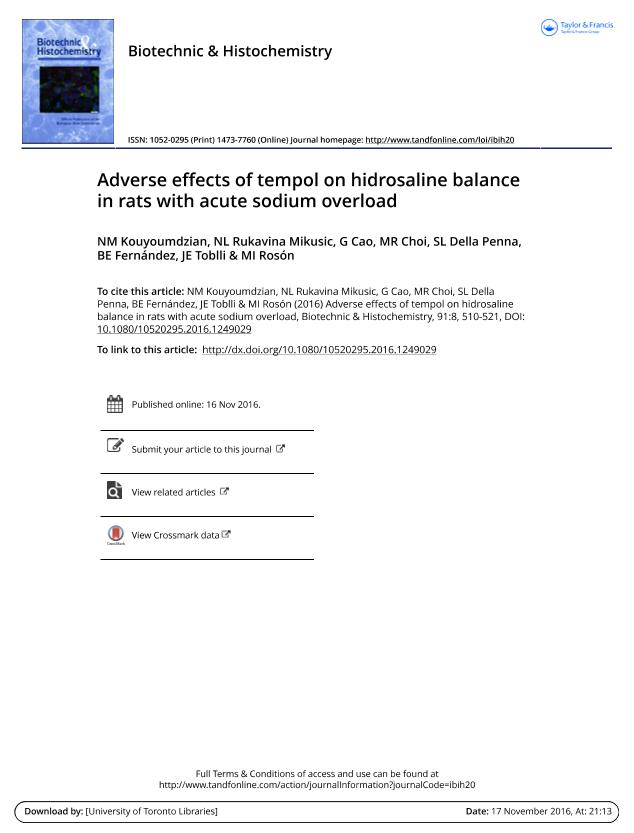Artículo
Adverse effects of tempol on hidrosaline balance in rats with acute sodium overload
Kouyoumdzian, Nicolás Martín ; Rukavina Mikusic, Natalia Lucía
; Rukavina Mikusic, Natalia Lucía ; Cao, Gabriel Fernando
; Cao, Gabriel Fernando ; Choi, Marcelo Roberto
; Choi, Marcelo Roberto ; Della Penna, Silvana; Fernandez, Belisario Enrique
; Della Penna, Silvana; Fernandez, Belisario Enrique ; Toblli, Jorge Eduardo
; Toblli, Jorge Eduardo ; Roson, Maria Ines
; Roson, Maria Ines
 ; Rukavina Mikusic, Natalia Lucía
; Rukavina Mikusic, Natalia Lucía ; Cao, Gabriel Fernando
; Cao, Gabriel Fernando ; Choi, Marcelo Roberto
; Choi, Marcelo Roberto ; Della Penna, Silvana; Fernandez, Belisario Enrique
; Della Penna, Silvana; Fernandez, Belisario Enrique ; Toblli, Jorge Eduardo
; Toblli, Jorge Eduardo ; Roson, Maria Ines
; Roson, Maria Ines
Fecha de publicación:
11/2016
Editorial:
Informa Healthcare
Revista:
Biotechnic and Histochemistry
ISSN:
1052-0295
Idioma:
Inglés
Tipo de recurso:
Artículo publicado
Clasificación temática:
Resumen
We studied the effects of tempol, an oxygen radical scavenger, on hydrosaline balance in rats with acute sodium overload. Male rats with free access to water were injected with isotonic (control group) or hypertonic saline solution (0.80 mol/l NaCl) either alone (Na group) or with tempol (Na-T group). Hydrosaline balance was determined during a 90 min experimental period. Protein expressions of aquaporin 1 (AQP1), aquaporin 2 (AQP2), angiotensin II (Ang II) and endothelial nitric oxide synthase (eNOS) were measured in renal tissue. Water intake, creatinine clearance, diuresis and natriuresis increased in the Na group. Under conditions of sodium overload, tempol increased plasma sodium and protein levels and increased diuresis, natriuresis and sodium excretion. Tempol also decreased water intake without affecting creatinine clearance. AQP1 and eNOS were increased and Ang II decreased in the renal cortex of the Na group, whereas AQP2 was increased in the renal medulla. Nonglycosylated AQP1 and eNOS were increased further in the renal cortex of the Na-T group, whereas AQP2 was decreased in the renal medulla and was localized mainly in the cell membrane. Moreover, p47-phox immunostaining was increased in the hypothalamus of Na group, and this increase was prevented by tempol. Our findings suggest that tempol causes hypernatremia after acute sodium overload by inhibiting the thirst mechanism and facilitating diuresis, despite increasing renal eNOS expression and natriuresis.
Archivos asociados
Licencia
Identificadores
Colecciones
Articulos(ININCA)
Articulos de INST.DE INVEST.CARDIOLOGICAS (I)
Articulos de INST.DE INVEST.CARDIOLOGICAS (I)
Citación
Kouyoumdzian, Nicolás Martín; Rukavina Mikusic, Natalia Lucía; Cao, Gabriel Fernando; Choi, Marcelo Roberto; Della Penna, Silvana; et al.; Adverse effects of tempol on hidrosaline balance in rats with acute sodium overload; Informa Healthcare; Biotechnic and Histochemistry; 91; 8; 11-2016; 510-521
Compartir
Altmétricas



